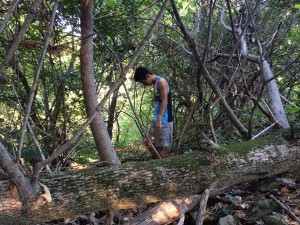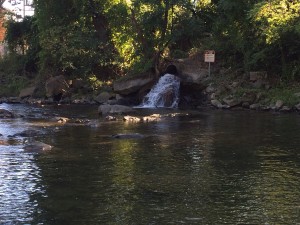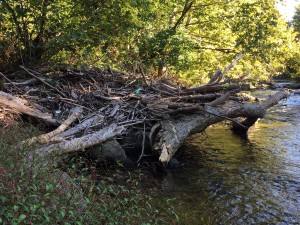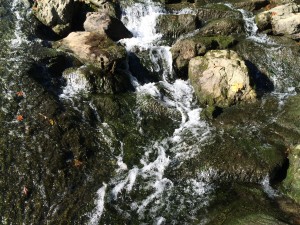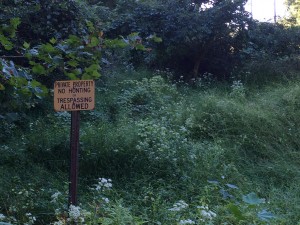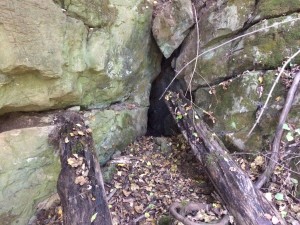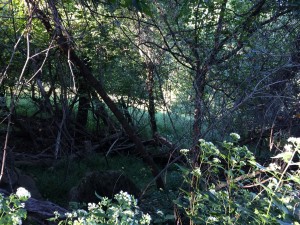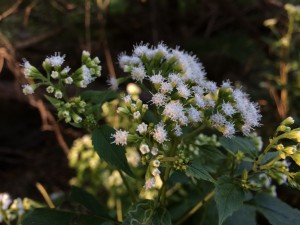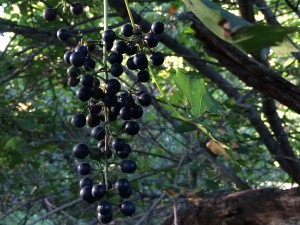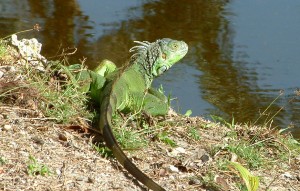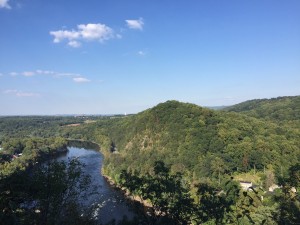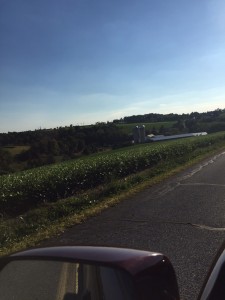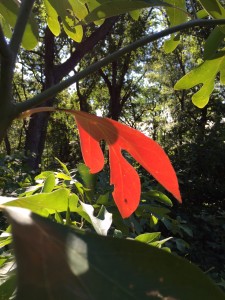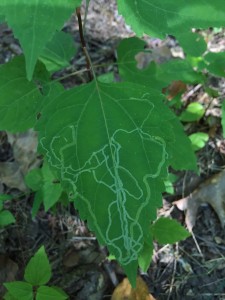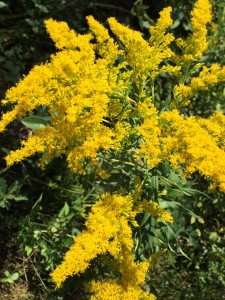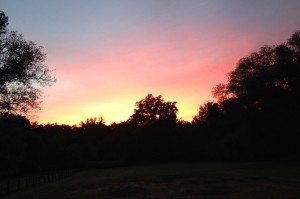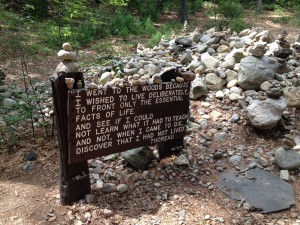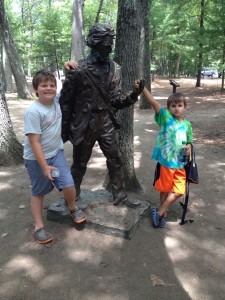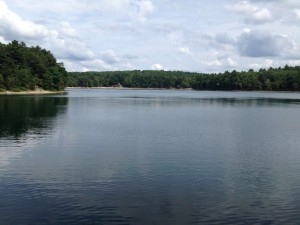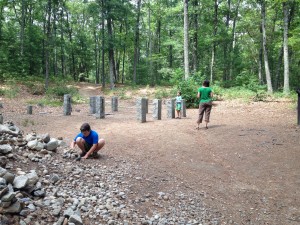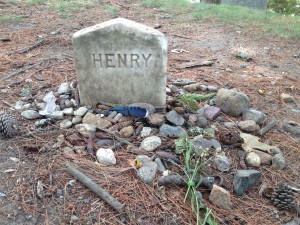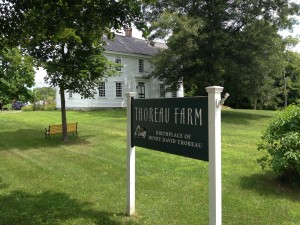Monthly Archives: September 2015
The Iguana
“The Iguana” (1937)
by Isak Dinesen
In the reserve I have sometimes come upon the iguanas, the big lizards, as they were sunning themselves upon a flat stone in a river-bed. They are not pretty in shape, but nothing can be imagined more beautiful than their colouring. They shine like a heap of precious stones or like a pane cut out of an old church window. When, as you approach, they swish away, there is a flash of azure, green, and purple over the stones, the colour seems to be standing behind them in the air, like a comet’s luminous tail.
Once I shot an iguana. I thought that I should be able to make some pretty things from his skin. A strange thing happened then, that I have never afterwards forgotten. As I went up to him, where he was lying dead upon his stone, and actually while I was walking the few steps, he faded and grew pale; all colour died out of him as in one long sigh, and by the time that I touched him he was grey and dull like a lump of concrete. It was the live impetuous blood pulsating within the animal which had radiated out all that glow and splendour. Now that the flame was put out, and the soul had flown, the iguana was as dead as a sandbag.
Often since I have, in some sort, shot an iguana, and I have remembered the one in the Reserve. Up at Meru I saw a young Native girl with a bracelet on, a leather strap two inches wide, and embroidered all over with very small turquoise-coloured beads which varied a little in colour and played in green, light blue, and ultramarine. It was an extraordinarily live thing; it seemed to draw breath on her arm, so that I wanted it for myself, and made Farah buy it from her. No sooner had it come upon my own arm than it gave up the ghost. It was nothing now, a small, cheap, purchased article of finery. It had been the play of colours, the duet between the turquoise and the ‘nègre’ — that quick, sweet, brownish black, like peat and black pottery, of the Native’s skin that had created the life of the bracelet.
In the Zoological Museum of Pietermaritzburg, I have seen, in a stuffed deep-water fish in a showcase, the same combination of colouring, which there had survived death; it made me wonder what life can well be like, on the bottom of the sea, to send up something so live and airy. I stood in Meru and looked at my pale hand and at the dead bracelet. It was as if an injustice had been done to a noble thing, as if truth had been suppressed. So sad did it seem that I remembered the saying of the hero in a book that I had read as a child: “I have conquered them all, but I am standing among graves.”
In a foreign country and with foreign species of life one should take measures to find out whether things will be keeping their value when dead. To the settlers of East Africa I give the advice: ‘For the sake of your own eyes and heart, shoot not the Iguana.’
more images
Getting Lost
On Friday, I took a trip up to Gollub Park on the ridge to the North of campus. I didn’t have much of a plan and didn’t know anything about the area other than the views of the Delaware that Professor Brandes mentioned in class.
When I arrived at the entrance to the park, I was surprised to find dense forest that seemed to extend entirely down the ridge on both sides. I wandered along the trail for 10 minutes or so before coming to the fork in the trail. I still hadn’t found any great views, but decided to take the downstream path which seemed to slope down towards the river. After 20 more minutes of wooded trail, I was getting frustrated that I couldn’t really see the river… and then I stopped. Once I took a moment to examine my surroundings, I realized that for the first time all week, everything around me was almost completely silent. I could even hear the leaves rustling as the breeze drifted through the trees. It was an incredibly peaceful moment.
At some point, about 25 minutes in, I decided to turn back towards the fork in the trail. When I reached the intersection, I continued straight. I only had to hike another hundred yards or so before I encountered a large outcropping of rocks that looked out over the Delaware. It was awesome!
I hadn’t known where I was going, but throughout my walk in the woods, I felt at ease. As we talked about on our kayaking trip, there is a sense of freedom that many of us feel when we get off campus and into nature.
Inspired by my experience getting “lost” in Gollub Park, I decided to spend the rest of the afternoon exploring. When I got back to my car (sorry, I drove there), I decided that I was going to take a right down the backside of the ridge and away from Lafayette. With no plan and a minimal sense of direction, I drove what seemed to be North for about 30 minutes. For miles, I passed nothing but corn fields, glimmering in the golden afternoon light. I had never been to this area, but just like Gollub Park, I found it to be naturally beautiful and free of the hustle and bustle of the Easton area.
When the sun started to set, I pulled out my phone for the first time in hours. “Siri, take me to Lafayette College,” I said.
Story of Place – Bushkill Park
Jackie, Jeremy and I are working with the Bushkill park for our story of place project. We visited our site once so far, and found it to be private property, protected by fences and gates. From the outside we could tell it was in a place that could have been effected by flooding, and we hope to research further into that. This location also has a lot of human history. In researching the location, Jackie came across an episode of American Pickers (on the history channel) on the Bushkill park! Using this video we are able to get a peek into the inside of the park without actually going in. We are still hoping to get in touch with the owner to find a way to have a tour or for us to go in with permission. To do this, Jackie is emailing the reporter of an article about the park in hopes that he can direct us to the owner.
Because we couldn’t head into the actual park, we decided to walk near the creek, there is a part of the bike trail running next to it. On one side of the path was the Bushkill, then the road and houses. The other side ran along backyards. The side wit the creek, has been a designated wilderness preserve, which we found very interesting, as it doesn’t protect much, especially with a road and houses being next to it. The backyards on the other side had large trees, but you could tell it used to be a forest. There were piles of stuff (branches, leaves, etc) nicely sorted on the grass, and the grass itself was well manicured. Even though the houses aren’t very visible, we know it is someones property.
American Pickers: https://www.youtube.com/watch?v=ay8zfyRpHGM
(I tried to upload this with pictures multiple times but it wouldn’t seem to post with them, next time (when there are more than two pictures) I’ll have them all uploaded to an online site and share the link)
USA
Reading Diary of a Citizen Scientist I am constantly struck at simply how vast the landscape of the United States is. I know it may sound elementary, but it is hard for me, from New Jersey, to really ever imagine a rainfall that would lead people to begin evacuating a town, as Russell explains. Having never been out west, the stories from people who have gone there from my area are practically all the same: you have to go there, its so grand, its so different.
I think we are lucky to live in the United States because of its size and different topography, landscapes, and composition from sea to sea. There is so much to see and experience that you could probably feel like you indeed were in a different country depending on how far away from home you were. I am an East Coast creature; I’ve been to every state on the Atlantic coastline and I spend most of my time in Massachusetts and New Jersey, so I have yet to have that epiphany moment where I feel as if I have left the boundaries of our nation, but I cannot wait for that day. This is why I am enjoying reading Citizen Scientist, not so much for the description of tiger beetles, but because of the description of places that are out there, in our country, waiting to be visited, studied, and enjoyed. I could never imagine having an irrigation ditch near my house, but as the author explains, that is simply commonplace where she is from. What a vast country we live in.
pics of nature
some pics from Walden, Mass
On Thursday, my biology class went back to the Sullivan Park wetland and had the opportunity to get down and dirty in it. Let me say that it is a very different experience to be looking in at the wetland from behind the fence than when you are right in the thick of things. My first task was to get into the wetland. This was much more difficult than I anticipated – the cattails and undergrowth were deceivingly thick. I found that in order to move at all we had to crush some of the plants. That action in itself felt very wrong. Here is a small preserved piece of wetland and what was my right to be invading its space and leaving a trail of broken stems behind me?
The wetland quickly had its revenge on me as I tried to make my way out of the heavily planted area. I headed towards the fountain and suddenly found myself up to my waist in water. I was wearing waist high waders but it was definitely a surprise to find out that I needed every last inch of them to keep me dry. It was an odd experience to feel the water surrounding me, feeling the pressure of the water for the entire wetland press against my legs but to not be getting wet. I could feel the water swilling around me as it took me in its stride as just another obstacle to move around in its journey through the wetland.
There was a strange sense of calm when I finally made my way into the center of the wetland. Even though my classmates were less than 10 feet away from me and I could hear them very distinctly, the plants were so thick that I could not see them at all. It was a very real experience to feel so alone while knowing that others were so close. Had it not been for them, I could have been miles away from any human or any part of civilization for all I knew. I was lucky to be allowed to go to a place where so many others get so close to but can’t quite experience themselves.
Gorp at Sullivan Park
When Professor Brandes told us we would have the first 15 minutes of class to just sit in silence I was thrilled. With all of the homework that I have and extracurricular activities that I balance, I never can find the time to just sit and not think about everything that I have to do. I picked a small spot right on the edge of the park that was the last piece of manicured grass before the tree line.
First I focused on touch. The grass tickled my bare legs and I could feel the small bugs itching my skin in a way that it felt they were crawling all over me. I normally would get up and shake off that feeling but I was dedicated to take advantage of my alone time at the Park.
Next, I focused on sound. I close my eyes and I felt that all I could hear was the whirring of cars and the clicking of bugs. I was disappointed that I could hear the footprint of man when all I was trying to do was breakaway from reality. I spent some time thinking about this frustration but I told myself that I shouldn’t be frustrated by this and that I had to refocus my attention. I had to accept that I was not very secluded and that it is so rare to not find the presence of humans. So I started to think about how the bugs were just as loud as the cars. They seemed to be competing for the attention of my ears and I shocked that the bugs were capable of fighting off the sound of cars.
As I opened my eyes I focused on sight. When I was sitting I saw the bushes in front of me shake. I watched the tree tops and focused in on the squirrels and birds that carried along with their tasks without even realizing I was there. I sat and looked for a while thinking that I could see it all from my seated position. Despite this thought I eventually I rose up and walked even closer to the edge of the woods. As I did this a deer scurried away, unlike the birds and squirrels it realized that there was an intruder. I saw the bed of a seemingly dried up creek but as I leaned in I saw a subtle trickle of water in it, something that I would not have noticed had I stayed in the grass. I wanted so badly to climb through the brush to get a closer look but growing up on the beaches of Long Island I know that ticks are always lurking nearby and that lymes disease is no joke. A tiny voice told me I could not explore more and I knew that I was not living up to the expectations of this class by stopping due to a redeveloped fear. However, I could not shake this fear that I have had since I was a child and so I never made it to explore the creek in Sullivan Park.
Instead I looked up to the sky and found a bird circling over head. At first I thought it was a vulture but before I could get a better look I heard Professor Brandes calling for us to return to home base. When I looked back up to find the bird it seemed to have disappeared- if only I could have followed that bird like I wanted to follow the creek that was hidden in the brush.

